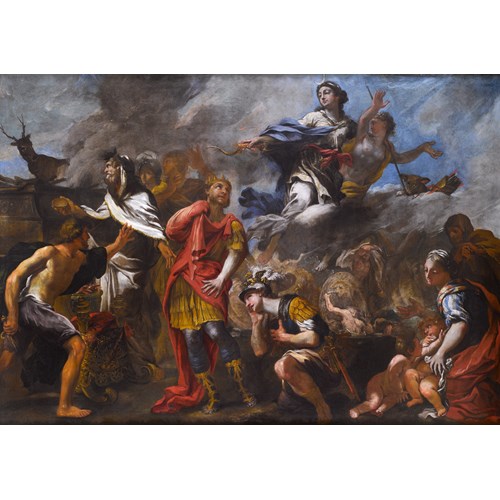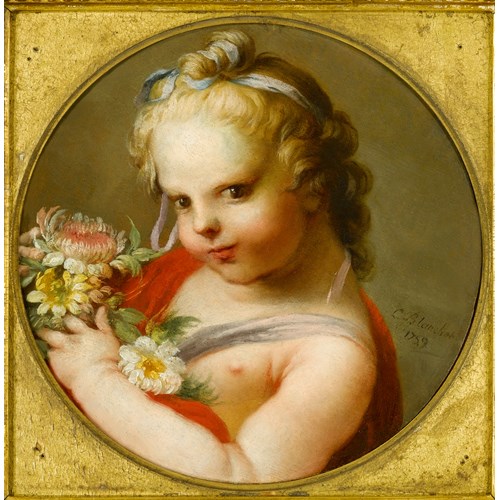Marketplace
Coste della Crimée
Carlo Bossoli
Coste della Crimée
Date 1842
Period 1750-1850, 19th century
Origin Italy
Medium Watercolour
Dimension 27 x 21 cm (10³/₅ x 8³/₁₀ inches)
A mother and daughter look out from the banks of a river in Crimea. The tributary has run almost completely dry, leaving an unsuspecting boat stranded on its bed. The scene appears to have mesmerised the two, as well as catching the attention of others who have approached the vessel to examine it, their reflections caught on the glistening surface of the riverbed.
The woman’s son, his dog sniffing around nearby, appears to be less interested in the goings on, and with his back to the scene looks towards his mother as though pleading with her to move on. Her headdress and shoes, pointed at the toe, suggest that she may be a Crimean Tatar. Beside the family group lies another of the river’s discarded contents, a wooden door. The fluid, wet brushstrokes of the muddied waters surrounding it stand in contrast to the dry brush swept across the surface of the paper to create the textured surface of the riverbank.
The present watercolour is believed to have been executed in c.1842. Carlo Bossoli visited Crimea several times between 1828 and 1843, most extensively from 1840 to 1842. His watercolours and gouaches executed in Crimea are particularly decorative and detailed, and depict a variety of scenes taken from daily life, such the streets of Sevastopol, the port of Yalta, or a simple snapshot as exemplified in Coste della Crimée. A series of lithographs also produced during this period were later reused by Bossoli during the 1850s to create new works of Crimea.
When the Crimean War was declared in 1854, Bossoli went to London. Britain’s involvement in the conflict meant that there was a considerable demand for panoramic views of Crimea; Bossoli enjoyed notable success, selling many of his newly worked watercolours of Crimea to the British nobility, including James Beaumont Neilson (1792-1865), the Marquess of Waterford, Lord Francis Egerton (1800-1857), Baroness Mayer Rothschild (1819-1884) and the Duke of Wellington (1769-1852). Queen Victoria (1819-1901), was also a great admirer of Bossoli, and purchased four of his Crimean works. Bossoli’s Crimean scenes of this period were characterised by their idyllic and peaceful air. In 1856, Day & Son, lithographers to Queen Victoria, published a series of his lithographs entitled The Scenery of the Crimea. The popular prints were of considerable ethnographic and geographic interest, and included depictions of Tatar life.
Bossoli was born in 1815 in Davesco, near Lugano. At a young age he emigrated to Odessa with his family. At eighteen years of age he sold his first works, predominantly cityscapes and other vistas, and promptly received commissions from the court of St. Petersburg. In 1845 he returned to Milan, but continued to work across Europe. In 1853 Bossoli lived in Piedmont where he started to paint historical depictions of events from the Crimean War. He travelled to Morocco, painting for the court of Queen Victoria and the Empress Eugénie (1826-1920), wife of Napoleon III (1808-1873), for whom he executed views of Spain. His paintings had a brief period of success in London, where they were published by Day & Son. He exhibited at The Royal Academy between 1855 and 1859. Panoramic views showing the straits of the Bosphorus and the towns and forts associated with battles such as Balaklava and Sevastopol were much in demand as were prints of Scutari, the military hospital run by Florence Nightingale (1820-1910).
For his meticulous and precise work Bossoli was appointed historical painter to Prince Eugene of Savoy. His views and prints are scattered across museums and private homes all over Europe. His landscapes, urban views, and military depictions are characterised by empirical detail, as seen in his use of colour and his treatment of landscape and weather.
This work previously formed part of the collection of Dr. Noemi Gabrielli, Curator of the Piedmont Galleries, and one of the experts appointed by the Archbishop of Turin, Cardinal Michele Pellegrino, in 1969 and again in 1973, to study the Turin Shroud. The present work is probably a version of a work with the same title which is shown in the 1974 exhibition catalogue, plate 4 (see Literature).
The woman’s son, his dog sniffing around nearby, appears to be less interested in the goings on, and with his back to the scene looks towards his mother as though pleading with her to move on. Her headdress and shoes, pointed at the toe, suggest that she may be a Crimean Tatar. Beside the family group lies another of the river’s discarded contents, a wooden door. The fluid, wet brushstrokes of the muddied waters surrounding it stand in contrast to the dry brush swept across the surface of the paper to create the textured surface of the riverbank.
The present watercolour is believed to have been executed in c.1842. Carlo Bossoli visited Crimea several times between 1828 and 1843, most extensively from 1840 to 1842. His watercolours and gouaches executed in Crimea are particularly decorative and detailed, and depict a variety of scenes taken from daily life, such the streets of Sevastopol, the port of Yalta, or a simple snapshot as exemplified in Coste della Crimée. A series of lithographs also produced during this period were later reused by Bossoli during the 1850s to create new works of Crimea.
When the Crimean War was declared in 1854, Bossoli went to London. Britain’s involvement in the conflict meant that there was a considerable demand for panoramic views of Crimea; Bossoli enjoyed notable success, selling many of his newly worked watercolours of Crimea to the British nobility, including James Beaumont Neilson (1792-1865), the Marquess of Waterford, Lord Francis Egerton (1800-1857), Baroness Mayer Rothschild (1819-1884) and the Duke of Wellington (1769-1852). Queen Victoria (1819-1901), was also a great admirer of Bossoli, and purchased four of his Crimean works. Bossoli’s Crimean scenes of this period were characterised by their idyllic and peaceful air. In 1856, Day & Son, lithographers to Queen Victoria, published a series of his lithographs entitled The Scenery of the Crimea. The popular prints were of considerable ethnographic and geographic interest, and included depictions of Tatar life.
Bossoli was born in 1815 in Davesco, near Lugano. At a young age he emigrated to Odessa with his family. At eighteen years of age he sold his first works, predominantly cityscapes and other vistas, and promptly received commissions from the court of St. Petersburg. In 1845 he returned to Milan, but continued to work across Europe. In 1853 Bossoli lived in Piedmont where he started to paint historical depictions of events from the Crimean War. He travelled to Morocco, painting for the court of Queen Victoria and the Empress Eugénie (1826-1920), wife of Napoleon III (1808-1873), for whom he executed views of Spain. His paintings had a brief period of success in London, where they were published by Day & Son. He exhibited at The Royal Academy between 1855 and 1859. Panoramic views showing the straits of the Bosphorus and the towns and forts associated with battles such as Balaklava and Sevastopol were much in demand as were prints of Scutari, the military hospital run by Florence Nightingale (1820-1910).
For his meticulous and precise work Bossoli was appointed historical painter to Prince Eugene of Savoy. His views and prints are scattered across museums and private homes all over Europe. His landscapes, urban views, and military depictions are characterised by empirical detail, as seen in his use of colour and his treatment of landscape and weather.
This work previously formed part of the collection of Dr. Noemi Gabrielli, Curator of the Piedmont Galleries, and one of the experts appointed by the Archbishop of Turin, Cardinal Michele Pellegrino, in 1969 and again in 1973, to study the Turin Shroud. The present work is probably a version of a work with the same title which is shown in the 1974 exhibition catalogue, plate 4 (see Literature).
Date: 1842
Period: 1750-1850, 19th century
Origin: Italy
Medium: Watercolour
Dimension: 27 x 21 cm (10³/₅ x 8³/₁₀ inches)
Provenance: Maccagno Collection, Turin;
Collection of Dr. Noemi Gabrielli, Turin;
Swiss Private Collection (since 1976)
Literature: Carlo Bossoli: Fifty years of European life in the Designs and the Paintings of the Ticinese Painter, Exhibition Catalogue, Luguno and Turin, 1974, Abb. 34, pl. 4.
More artworks from the Gallery









